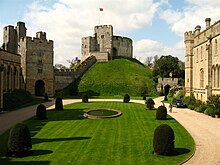Arundel Castle

Arundel Castle [ ærəndəl or in local pronunciation ɑːndəl ] is a castle in the village of Arundel in West Sussex . The name Arundel is made up of the name of the river Arun and the Old English word del (river). The river flows through the South Downs near the English south coast.
Arundel Castle is one of the best preserved medieval castles and one of the most impressive castles in Britain. Arundel Castle was built in the 11th century in the time of Edward the Confessor in the typical fortress style with battlements and drawbridges and was completed under Roger de Montgomerie, 1st Earl of Shrewsbury . Since 1141 until today it has been the befitting seat of the Earl of Arundel , who has also had the title of Dukes of Norfolk since 1660 . The castle was damaged in the English Civil War and restored in the 18th and 19th centuries. The 16th Duke had planned to hand the castle over to the National Trust , but after his death in 1975, the 17th Duke canceled that plan. He set up an independent, non-profit foundation to secure the future of the palace and oversaw the restoration work.
Most of the castle can be visited for an entrance fee. Only the private rooms are excluded. There are also regular events, preferably medieval knight tournaments but also open air theater performances.
Palace and park complex
Originally the castle was built as a mound castle on a moth and was supposed to protect the estuary against invaders. Over the centuries it was expanded into a castle and rebuilt several times. Within Arundel Castle is the original FitzAlan Chapel , which is now a private mausoleum and used as a burial place for the Dukes of Norfolk.
The construction of the horseshoe-shaped building complex on a hill provides a view of the 40 hectare gardens around the castle and includes some old cork and ginkgo trees , themed gardens and the Victorian greenhouse.
In the place of the lower outer bailey there is a square with towers and chimneys. In the castle, the barons' hall is the centerpiece of the premises. It is 40 meters long, 15 meters high and is characterized by a solid oak ceiling. The interior displays a rich and varied collection of furniture, paintings, tapestries and valuable artefacts from the Victorian era. The armory contains combat and ceremonial weapons. In the “small salon” there are landscape paintings and portraits by Canaletto . The heraldic fireplace of the drawing room and the white and gold furniture of the Victoria Room were specially commissioned for a royal visit in 1846. The suite Victoria stayed in is now part of the family's private apartments, but the furniture has been exposed to the public. You can see the queen's bed, the guest book with significant signatures and her toilet. In addition to the picture gallery and the 37-meter-long Regency library made of mahogany with around 10,000 books, the magnificent dining room impresses with its lancet windows that are reminiscent of a chapel. This room is located in the former medieval chapel and is furnished with fine furniture, cutlery and memorabilia - in particular Queen Victoria's coronation homage chair and a glass cabinet that contains, among other things, the rosary beads that Mary Stuart wore on her belt when she was executed.
The south passage is an oval keep with a ring wall, part of the inner gatehouse and several towers.
Web links
Individual evidence
- ↑ a b Arundel Castle, West Sussex at historyextra.com, accessed May 30, 2019.
- ↑ The Duke of Norfolk at telegraph.co, accessed May 30, 2019.
- ↑ events at arundelcastle.org, accessed on May 30 of 2019.
- ↑ Arundel Castle at www.set.de, accessed May 30, 2019.
Coordinates: 50 ° 51 ′ 20 ″ N , 0 ° 33 ′ 14 ″ W.

